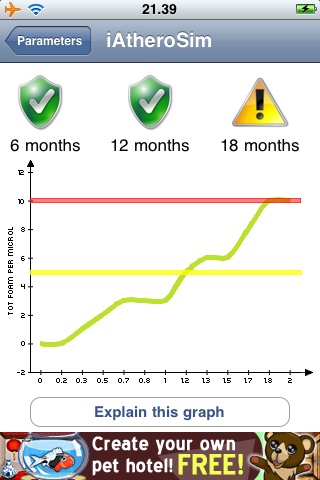
iAtheroSim app for iPhone and iPad
Developer: Bizmate Srl
First release : 14 Jun 2011
App size: 4.18 Mb
Atherosclerosis, a pathology affecting arterial blood vessels, is one of most common diseases of developed countries. It is, in large part, due to the deposition of low density lipoproteins (LDL), i.e. plasma proteins carrying cholesterol and triglycerides that determine the formation of multiple plaques within the arteries [1]. The origin of atherosclerosis is still not fully understood.
There are risk factors that increase the probability of developing atherosclerosis in humans. Some of these are within a person’s control (smoking, obesity), while others seem to have a genetic origin (familial hypercholesterolemia, diabetes, hypertension) [2].
The common denominator in all forms of atherosclerosis is the elevated level of LDL, which is subject to oxidation, becoming oxidized LDL (oxLDL) that promotes inflammatory response and immune system activation in the artery walls [3]. The formation of atherosclerotic plaques in the artery reduces both the internal diameter of vessels and the blood flux, leading to a number of serious pathologies.
Atherosclerosis and their anatomical consequences cause severe problems. Stenosis (narrowing) and aneurysm of the artery are chronic, progress slowly, and are the cumulative effects indicative of the progression of atherosclerotic disease. In both case the result is an insufficient blood supply to the organ fed by the artery. Most commonly, soft plaque suddenly ruptures, causes the formation of a thrombus that will rapidly slow or stop blood flow, leading to death of the tissues fed by the artery. This catastrophic event is called infarction and is not predictable. The most common event is thrombosis of the coronary artery causing infarction (a heart attack). However, since atherosclerosis is a body-wide process, similar events also occur in the arteries of the brain (stroke attack), intestines, kidneys, etc. Those atherosclerosis-associated events are often the cause of death or serious invalidate diseases and require preventive treatments.
As atherosclerosis is recognized as an immune system-related pathology, recently we proposed a model based on the Agent Based Model (ABM) paradigm [4], which reproduces clinical and laboratory parameters associated to atherogenesis. The model and its computer implementation (SimAthero simulator) is accessible through the iAtheroSim iPhone application and produces as output the prediction on the risk of plaque formation at 6, 12 and 18 months, considering relevant personal parameters given by the user.
References:
[1] Hanson GK. 2002. Inflammation, atherosclerosis, and coronary artery disease. N Engl J Med 352(16): 1685-95.
[2] Romero-Corral A, Somers VK, Korinek J, et al. 2006. Update in prevention of atherosclerotic heart disease: management
of major cardiovascular risk factors. Rev Invest Clin 58(3): 237-44.
[3] Weber C, Zernecke A, Libby P. 2008. The multifaceted contributions of leukocyte subsets to atherosclerosis:
lessons from mouse models. Nat Rev Immunol 8(10): 802-15.
[4] Pappalardo F, Musumeci S, Motta S. 2008. Modeling immune system control of atherogenesis. Bioinformatics 24(15)
1715-21.


